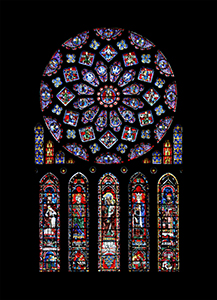|
Gothic and Roman Art Characterizes the Middle Ages
by Gabby Seals, age 16

During the Middle Ages (400-1400 A.D.), art influenced the lives of the European people. Romanesque and Gothic art dominated Europe. Mainly displayed in the church, both styles significantly impacted European culture, in ways that are still evident today.
Romanesque art can be thought of as big, bulky, and beautiful, with a very simplistic style. Although it was displayed mostly as wall paintings, Romanesque art also illustrates manuscripts and books of the time. Gothic art manifested itself in the architecture of the church itself; it was characterized by pointed, ornate, and very tall structures.
Romanesque art was fading by the 1100s as Gothic art inched its way into the mainstream. Gothic stained-glass windows, first used in European churches, soon took up wall-space that may have otherwise been filled by Romanesque wall paintings. Gothic-style churches were built to look bright and open to draw attention heavenwards.
The Middle Ages were a period of relative stability in Europe. Cities were growing and universities were founded, amid efforts to end the feudal system. The feudal system was a set of legal and military customs considered the “Law of the Land.” This system created a corrupt government that gave the upper class citizens privilege over lower class citizens. The Middle Ages also saw a growth in the number of churches, which led to a higher demand for art.
The process of changing from Romanesque art to Gothic Art was more of an evolutionary than a revolutionary process. Because art had ripple effects on geographical, religious, and societal aspects of western Europe, the shift between these two types of art was gradual. Although Gothic artists were competing against Romanesque artists for popularity, they each had their time to shine.
[Source: http://www.bbc.co.uk/history/british/architecture_01.shtml; Art That Changed The World]
|

